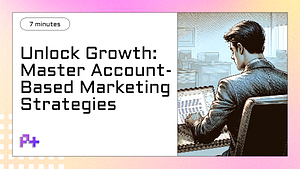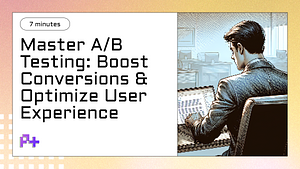Summary
- 1. Understanding Product-Led Growth (PLG) and Sales-Led Growth (SLG)
- 2. Key Differences Between PLG and SLG Strategies
- 3. The Hybrid Model: Combining the Best of Both Approaches
- 4. Refining Your Strategy: Best Practices for Product-Led and Sales-Led Growth
- 5. Choosing the Right Growth Strategy for Your SaaS Business

1. Understanding Product-Led Growth (PLG) and Sales-Led Growth (SLG)
In the ever-evolving landscape of business strategies, understanding the distinction between Product-Led Growth (PLG) and Sales-Led Growth (SLG) is crucial for organizations aiming to optimize their revenue streams. Product-Led Growth emphasizes the product itself as the primary driver of customer acquisition, retention, and expansion. By allowing potential customers to experience the value of the product through free trials or freemium models, companies can generate organic interest and facilitate a natural sales process. This approach often leads to a more engaged user base, as customers who have firsthand experience with the product are more likely to convert into paying users.
On the other hand, Sales-Led Growth focuses on leveraging sales teams to drive revenue. This strategy typically involves a more traditional approach, where sales representatives actively reach out to prospects, nurturing leads through personalized interactions. In this model, the sales team plays a pivotal role in educating customers about the products benefits and features, guiding them through the purchasing process, and ultimately closing deals. While this method can be effective, it often requires substantial resources and may lead to longer sales cycles, as the emphasis is placed on human interaction rather than the product itself.
Both Product-Led Growth and Sales-Led Growth have their unique advantages and challenges, and the choice between them often depends on the nature of the product and the target market. Companies in rapidly evolving sectors, such as tech and SaaS, may find that a PLG approach aligns better with their goals, as it allows for faster scaling and customer feedback loops. Conversely, businesses in more complex industries may benefit from SLG, where personal relationships and tailored solutions are essential to address customer needs. Understanding these two growth strategies is vital for organizations to determine the best approach for their sales and marketing efforts, ultimately driving sustainable growth and success in a competitive environment.

2. Key Differences Between PLG and SLG Strategies
When comparing Product-Led Growth (PLG) and Sales-Led Growth (SLG) strategies, its essential to understand their foundational differences and how they shape the customer journey. PLG focuses on delivering value directly through the product, allowing users to experience its benefits firsthand before committing to a purchase. This approach leverages user experience as a primary driver for adoption and retention. In contrast, SLG relies heavily on a sales team to drive revenue through direct engagement with potential customers. Here, the sales process is often characterized by personalized outreach, consultations, and relationship building, which can lead to a more traditional, lengthy sales cycle.
Another significant difference lies in the target audience and the role of customer feedback. In a PLG strategy, the product itself acts as the main marketing tool, making it crucial to gather user feedback continuously to refine the product and enhance user experience. This iterative process fosters a community-oriented approach where users often share their experiences, leading to organic growth through word-of-mouth. Conversely, SLG strategies typically emphasize targeted outreach and lead qualification, where sales teams analyze market segments to identify high-potential customers. This means that feedback may be gathered less frequently and is often filtered through sales representatives, which can slow down the adaptation process.
Lastly, the key performance indicators (KPIs) for PLG and SLG strategies differ significantly. PLG metrics often center around user engagement, product usage rates, and conversion rates from free trials or freemium models, which indicate how well the product resonates with users. On the other hand, SLG strategies focus on sales metrics such as deal size, sales cycle length, and customer acquisition cost. Understanding these differences is vital for businesses to align their growth strategies effectively. By recognizing whether to adopt a PLG approach or rely on SLG methods, companies can tailor their resources and efforts to best suit their market position and customer needs.
3. The Hybrid Model: Combining the Best of Both Approaches
The hybrid model of sales led growth merges the strengths of traditional sales strategies with modern growth tactics, creating a balanced approach that can drive significant business success. In this model, organizations leverage both outbound sales initiatives and inbound marketing efforts. This combination allows companies to not only reach potential customers proactively through targeted outreach but also create an ecosystem where prospects can discover and engage with the brand organically. By integrating these two approaches, businesses can enhance their customer acquisition strategies, leading to a more robust and sustainable growth trajectory.
One of the key advantages of the hybrid model is the ability to tailor customer engagement strategies to different stages of the buyer’s journey. For instance, while sales teams can initiate contact with high-potential leads through personalized outreach, marketing can nurture these leads through valuable content and resources that address their specific pain points. This synergy not only improves the overall customer experience but also increases the likelihood of conversion by ensuring that prospects receive the right information at the right time. By employing both sales-led techniques and marketing-driven strategies, companies can optimize their conversion funnels and maximize their return on investment.
To implement a successful hybrid model, businesses must foster collaboration between their sales and marketing teams. By aligning goals, sharing data, and developing integrated campaigns, organizations can ensure that both functions work towards common objectives. Regular communication and feedback loops between sales and marketing can lead to improved strategies that adapt to changing market conditions and consumer behaviors. This collaborative effort not only enhances operational efficiency but also cultivates a culture of growth that empowers teams to innovate and respond quickly to emerging opportunities, ultimately driving sustained sales led growth.
4. Refining Your Strategy: Best Practices for Product-Led and Sales-Led Growth
To effectively refine your strategy for both product-led and sales-led growth, it’s essential to understand the unique strengths of each approach and how they can complement one another. Product-led growth focuses on using the product itself as the main driver of customer acquisition, retention, and expansion. This means ensuring that your product delivers exceptional value and user experience, often through features like free trials or freemium models. On the other hand, sales-led growth emphasizes a more traditional approach, relying on direct sales efforts and relationships to drive revenue. By blending these strategies, companies can create a seamless experience that attracts customers at various stages of their journey.
One of the best practices for refining your strategy is to adopt a customer-centric mindset. Both product-led and sales-led growth benefit from understanding the needs and behaviors of your target audience. Utilize data analytics and customer feedback to identify pain points and preferences. This insight can help you tailor your product features to address specific needs while also informing your sales team on how to position your offerings effectively. Additionally, consider implementing a feedback loop between your product development and sales teams to ensure that insights from customer interactions are continuously integrated into product enhancements and sales pitches.
Moreover, leveraging technology can enhance both growth strategies. Tools such as Customer Relationship Management (CRM) systems and analytics platforms can provide valuable insights into customer interactions and buying patterns. For product-led growth, invest in user onboarding tools that guide new users through your product, highlighting key features that drive engagement. For sales-led growth, utilize sales enablement tools that equip your team with the resources they need to engage prospects effectively. By refining your strategy with these best practices, you can create a robust framework that supports sustainable growth, ensuring that both product and sales efforts are aligned toward common goals.
5. Choosing the Right Growth Strategy for Your SaaS Business
Choosing the right growth strategy for your SaaS business is crucial for long-term success and sustainability. One effective approach that has gained traction in recent years is sales led growth. This strategy focuses on building a strong sales team and leveraging their expertise to drive customer acquisition and retention. In a sales led growth model, the sales team plays a pivotal role in understanding customer needs, tailoring solutions, and providing personalized experiences that can significantly enhance customer satisfaction and loyalty. By investing in a skilled sales force, SaaS companies can create a more direct relationship with their clients, ultimately leading to increased revenue and market share.
However, while sales led growth can be highly effective, its essential to evaluate whether this approach aligns with your companys overall goals and resources. For example, if your SaaS product is relatively new or has a steep learning curve, a sales led strategy may provide the guidance and support potential customers need to make informed purchasing decisions. On the other hand, if your product is straightforward and can sell itself, a product-led growth strategy might be more suitable. Balancing these strategies can be key; some businesses find success by integrating sales led growth with product-led initiatives, allowing for a more comprehensive approach to customer acquisition and engagement.
Ultimately, the decision on which growth strategy to adopt should be driven by a thorough analysis of your target market, existing customer feedback, and competitive landscape. Conducting market research and gathering insights into customer preferences will help you determine whether a sales led growth strategy is the right fit for your SaaS business. Additionally, consider the scalability of your sales team and the resources required to maintain a sales-driven approach. By carefully weighing these factors, you can select a growth strategy that not only aligns with your business objectives but also positions you for sustained success in the dynamic SaaS marketplace.



